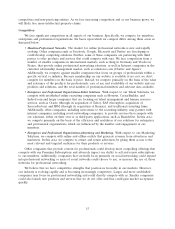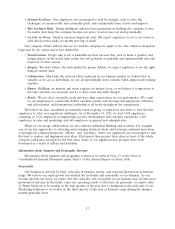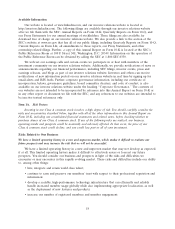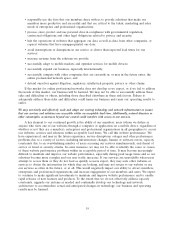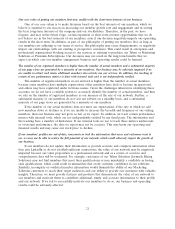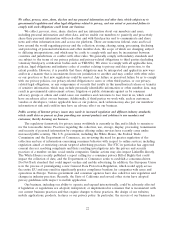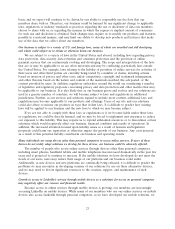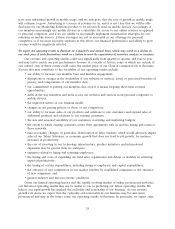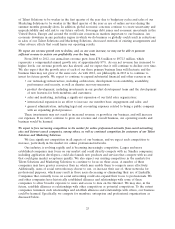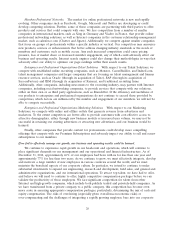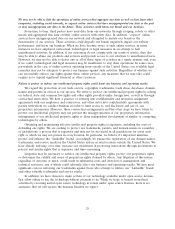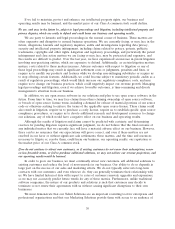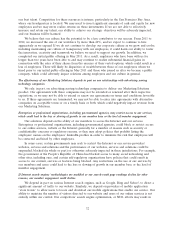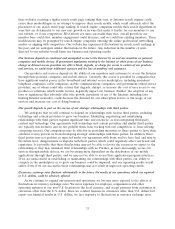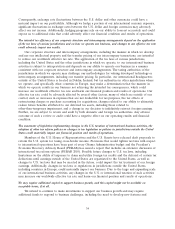LinkedIn 2012 Annual Report Download - page 27
Download and view the complete annual report
Please find page 27 of the 2012 LinkedIn annual report below. You can navigate through the pages in the report by either clicking on the pages listed below, or by using the keyword search tool below to find specific information within the annual report.of Talent Solutions to be weaker in the first quarter of the year due to budgetary cycles and sales of our
Marketing Solutions to be weaker in the third quarter of the year as use of online services during the
summer months generally slows. In addition, global economic concerns continue to create uncertainty and
unpredictability and add risk to our future outlook. Sovereign debt issues and economic uncertainty in the
United States, Europe and around the world raise concerns in markets important to our business. An
economic downturn in any particular region in which we do business or globally could result in reductions
in sales of our Talent Solutions and Marketing Solutions, decreased renewals of existing arrangements and
other adverse effects that could harm our operating results.
We expect our revenue growth rate to decline, and, as our costs increase, we may not be able to generate
sufficient revenue to sustain our profitability over the long term.
From 2008 to 2012, our annual net revenue grew from $78.8 million to $972.3 million, which
represents a compounded annual growth rate of approximately 87%. As our net revenue has increased to
higher levels, our revenue growth rate has slowed, and we expect that it will continue to decline over time.
We also expect that the growth rates of each of our three primary business lines will fluctuate and the
business lines may not grow at the same rate. As with 2012, our philosophy in 2013 is to continue to
invest for future growth. We expect to continue to expend substantial financial and other resources on:
• our technology infrastructure, including architecture, development tools scalability, availability,
performance and security, as well as disaster recovery measures;
• product development, including investments in our product development team and the development
of new features for both members and customers;
• sales and marketing, including a significant expansion of our field sales organization;
• international expansion in an effort to increase our member base, engagement and sales; and
• general administration, including legal and accounting expenses related to being a public company
with an expanding global presence.
These investments may not result in increased revenue or growth in our business, and will increase
our expenses. If we fail to continue to grow our revenue and overall business, our operating results and
business would be harmed.
We expect to face increasing competition in the market for online professional networks from social networking
sites and Internet search companies, among others, as well as continued competition for customers of our Talent
Solutions and Marketing Solutions.
We face significant competition in all aspects of our business, and we expect such competition to
increase, particularly in the market for online professional networks.
Our industry is evolving rapidly and is becoming increasingly competitive. Larger and more
established companies may focus on our market and could directly compete with us. Smaller companies,
including application developers, could also launch new products and services that compete with us and
that could gain market acceptance quickly. We also expect our existing competitors in the markets for
Talent Solutions and Marketing Solutions to continue to focus on these areas. A number of these
companies may have greater resources than us, which may enable them to compete more effectively.
Additionally, users of social networks may choose to use, or increase their use of, those networks for
professional purposes, which may result in those users decreasing or eliminating their use of LinkedIn.
Companies that currently focus on social networking could also expand their focus to professionals. We
and other companies have historically established alliances and relationships with some of these
companies to allow broader exposure to users and access to data on the Internet. We may also, in the
future, establish alliances or relationships with other competitors or potential competitors. To the extent
companies terminate such relationships and establish alliances and relationships with others, our business
could be harmed. Specifically, we compete for members, enterprises and professional organizations as
discussed below.
25


